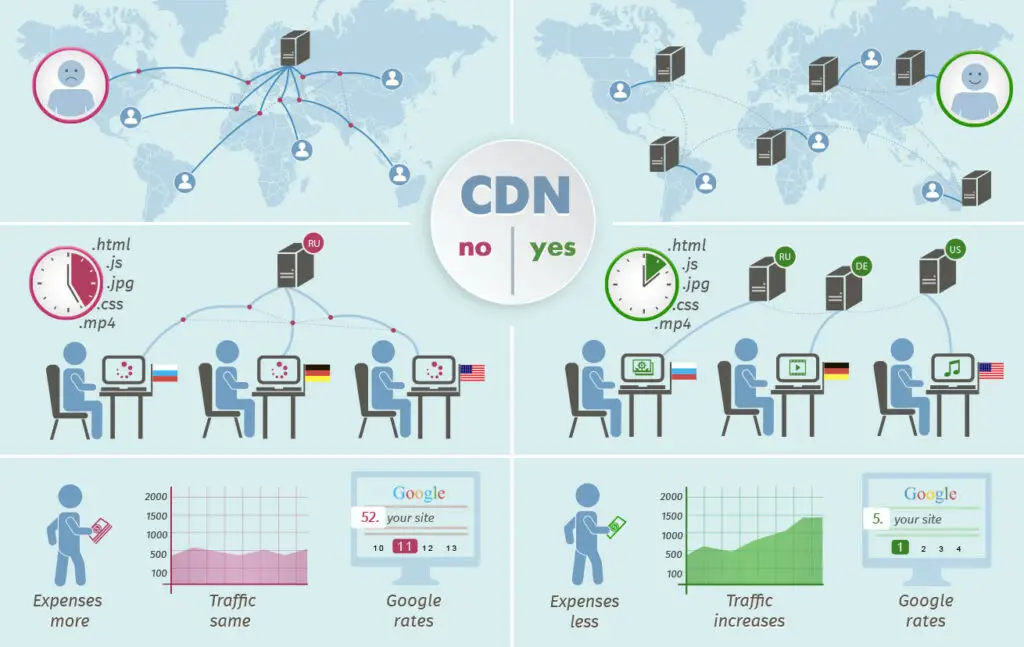The Role of CDNs in the Dynamic Delivery of Digital Advertising

Introduction:

Content delivery networks (CDNs) play a critical role in delivering digital advertising campaigns efficiently and effectively. By optimizing the delivery of ad content, CDNs enhance the user experience, improve ad performance, and drive business outcomes for advertisers.

Benefits of Using CDNs for Dynamic Ad Delivery:
1. Improved Ad Performance:
- CDNs cache ad content at edge locations closer to users, minimizing latency and ensuring faster loading times.
- This reduces the likelihood of ad timeouts and increases the chance of ad viewability, improving overall campaign effectiveness.
2. Enhanced User Experience:
- Fast ad loading times reduce interruptions to the user experience, making advertising less intrusive and more engaging.
- Smooth and responsive ad playback eliminates buffering and reduces user frustration, leading to positive brand perceptions.
3. Cost Efficiency:
- CDNs distribute ad content from multiple points of presence, reducing bandwidth costs for advertisers.
- By optimizing content delivery, CDNs help advertisers save on infrastructure expenses and improve their return on investment (ROI).
4. Advanced Targeting and Personalization:
- CDNs enable advertisers to target ads based on user demographics, location, and behavior.
- They can also deliver personalized ad experiences by serving different ad creatives to different users based on their preferences.
How CDNs Support Dynamic Ad Delivery:
- Content Caching: CDNs store ad content at strategically located edge servers, reducing latency and improving performance.
- Load Balancing: CDNs distribute traffic across multiple servers, preventing bottlenecks and ensuring consistent ad delivery.
- Caching Optimization: CDNs employ caching algorithms to determine how and where to store ad content for optimized delivery.
- Geographic Routing: CDNs route ad requests to the closest edge location based on the user’s IP address, minimizing latency.
- Protocol Support: CDNs support various protocols such as HTTP, HTTPS, and UDP to ensure compatibility with different ad delivery scenarios.
Conclusion:
CDNs are essential for delivering digital advertising campaigns with optimal performance, user experience, and cost efficiency. By caching ad content, optimizing delivery, and enabling advanced targeting and personalization, CDNs empower advertisers to engage users effectively and achieve their business goals. As the demand for dynamic and personalized advertising continues to grow, the role of CDNs will only become more critical in the future of digital advertising.# The Role Of Cdns In The Dynamic Delivery Of Digital Advertising
Executive Summary
The dynamic delivery of digital advertising is a complex process that requires a number of different technologies and services to work together seamlessly. One of the most important components of this process is the Content Delivery Network (CDN). A CDN is a network of servers that are distributed across the globe, and they work together to deliver content to users as quickly and efficiently as possible.
Introduction
In the past, digital advertising was delivered in a relatively static manner. Advertisers would create an ad, and then it would be delivered to users regardless of their location or device. However, the rise of mobile devices and the increasing popularity of online video has made it necessary for advertisers to adopt a more dynamic approach to ad delivery.
Why Are Cdns Important?
CDNs play a vital role in the dynamic delivery of digital advertising for a number of reasons. First, they can help to reduce latency, which is the amount of time it takes for an ad to load. Latency can be a major problem for advertisers, as it can cause users to lose interest in an ad or even abandon a website altogether.
Second, CDNs can help to improve the quality of ad delivery. By caching ads on their servers, CDNs can ensure that ads are delivered to users in a consistent and reliable manner. This can help to prevent problems such as pixelation, buffering, and dropped frames.
Third, CDNs can help to scale ad delivery. As the number of devices and users accessing the internet continues to grow, it is becoming increasingly important for advertisers to be able to deliver ads to a large number of people at the same time. CDNs can help to meet this demand by providing the infrastructure and bandwidth necessary to deliver ads to millions of users simultaneously.
FAQ
What are the benefits of using a CDN for digital advertising?
There are a number of benefits to using a CDN for digital advertising, including:
- Improved performance: CDNs can help to reduce latency and improve the overall quality of ad delivery.
- Increased reach: CDNs can help advertisers to reach a larger audience by delivering ads to users in all parts of the world.
- Cost savings: CDNs can help advertisers to save money by reducing the cost of ad delivery.
How do CDNs work?
CDNs work by caching ads on their servers. When a user requests an ad, the CDN will deliver the ad from the server that is closest to the user. This helps to reduce latency and improve the overall quality of ad delivery.
What are the different types of CDNs?
There are two main types of CDNs:
- Pull CDNs: Pull CDNs are the most common type of CDN. They work by pulling content from a central server when a user requests it.
- Push CDNs: Push CDNs work by pushing content to their servers in advance. This can help to improve performance by reducing the amount of time it takes to deliver an ad.
Top 5 Subtopics
1. Latency
Latency is the amount of time it takes for an ad to load. It is a major problem for advertisers, as it can cause users to lose interest in an ad or even abandon a website altogether.
- Causes of latency: Latency can be caused by a number of factors, including the distance between the user and the ad server, the size of the ad, and the number of users accessing the ad at the same time.
- How to reduce latency: There are a number of ways to reduce latency, including using a CDN, optimizing ad size, and using ad caching.
2. Quality of Delivery
The quality of delivery refers to the consistency and reliability of ad delivery. It is important to ensure that ads are delivered to users in a consistent and reliable manner, as this can help to prevent problems such as pixelation, buffering, and dropped frames.
- Factors affecting quality of delivery: The quality of delivery can be affected by a number of factors, including the CDN used, the ad format, and the user’s device.
- How to improve quality of delivery: There are a number of ways to improve the quality of delivery, including using a high-quality CDN, choosing the right ad format, and testing ads on a variety of devices.
3. Scalability
Scalability refers to the ability to deliver ads to a large number of users at the same time. It is important to ensure that ads can be delivered to a large number of users at the same time, as this can help to maximize reach and impact.
- Factors affecting scalability: The scalability of ad delivery can be affected by a number of factors, including the CDN used, the ad format, and the user’s device.
- How to improve scalability: There are a number of ways to improve scalability, including using a high-capacity CDN, choosing a lightweight ad format, and using ad caching.
4. Security
Security is an important consideration for any online activity, including digital advertising. It is important to ensure that ads are delivered to users in a secure manner, as this can help to protect user data and prevent fraud.
- Security threats: There are a number of security threats that can affect digital advertising, including malware, phishing, and clickjacking.
- How to improve security: There are a number of ways to improve security, including using a secure CDN, implementing SSL encryption, and using ad verification tools.
5. Cost
Cost is an important consideration for any business, including advertisers. It is important to ensure that the cost of ad delivery is kept to a minimum, as this can help to maximize ROI.
- Factors affecting cost: The cost of ad delivery can be affected by a number of factors, including the CDN used, the ad format, and the number of users targeted.
- How to reduce cost: There are a number of ways to reduce the cost of ad delivery, including negotiating with CDN providers, choosing the right ad format, and targeting the right audience.
Conclusion
CDNs play a vital role in the dynamic delivery of digital advertising. By caching ads on their servers, CDNs can help to reduce latency, improve the quality of ad delivery, and scale ad delivery to a large number of users. In addition, CDNs can help to improve security and reduce the cost of ad delivery. As the digital advertising landscape continues to evolve, CDNs will continue to play an increasingly important role in the delivery of ads to users around the world.
Keyword Tags
- Content Delivery Network (CDN)
- Digital advertising
- Latency
- Quality of delivery
- Scalability

